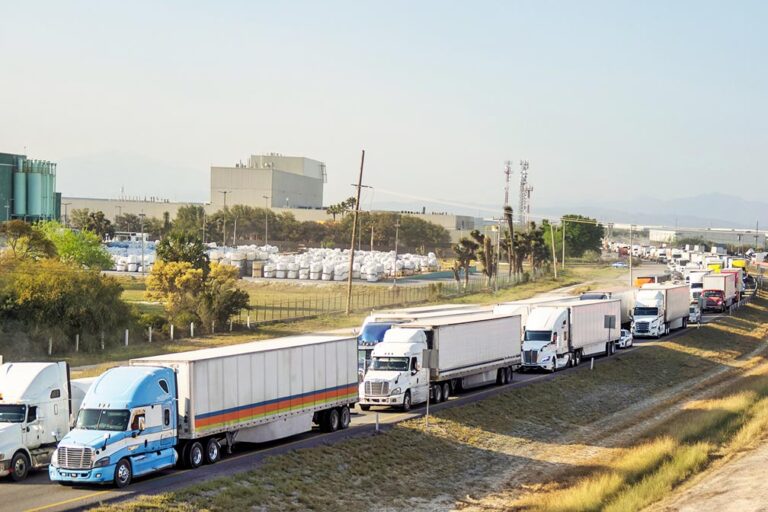WASHINGTON — The U.S. Environmental Protection Agency (EPA) on Friday, March 29, released strict emissions standards for heavy-duty trucks, buses and other large vehicles. Officials say the new standards will help clean up some of the nation’s largest sources of planet-warming greenhouse gases.
According to the EPA, the new rules, which take effect for model years 2027 through 2032, will avoid up to 1 billion tons of greenhouse gas emissions over the next three decades and provide $13 billion in net benefits in the form of fewer hospital visits, lost work days and deaths. In particular, the EPA said, the new standards will benefit an estimated 72 million people in the U.S. who live near freight routes used by trucks and other heavy vehicles and bear a disproportionate burden of dangerous air pollution.
The new rules for heavy trucks and buses come a week after the EPA announced new automobile emissions standards for passenger vehicles, which relax initial tailpipe limits proposed last year but get close to the same strict standards set out by the EPA for model year 2032.
The rule for trucks is complex, with a range of electric-vehicle or other non-traditional sales projected, depending on the type of vehicle and use, the EPA said. For instance, 30% of “heavy-duty vocational” trucks would need to be zero-emission by 2032, the EPA said, while 40% of short-haul “day cabs” would need be zero emission vehicles.
Not long after the EPA’s statement was released, trucking industry stakeholders — including fuel providers and retailers as well as motor carriers and others — were firing out responses, lambasting the new standards as unreachable with current electric-vehicle (EV) technology and pointing out a lack of EV charging stations and power grid capacity limits.
NATSO, representing America’s travel plazas and truck stops, and SIGMA: America’s Leading Fuel Marketers, said in a joint statement that while they appreciate that the Biden administration is working toward reducing carbon emissions, the new EPA rule is poised to have negative effects on trucking and its related industries.
“The administration’s final rule does not adequately consider the challenges that fuel retailers face in transitioning to heavy-duty truck electrification,” according to the statement. “The Administration’s Final Rule also does not recognize the need to support lower carbon alternatives to diesel fuel that are currently commercially viable, such as biodiesel and renewable diesel.”
NATSO pointed to a recent study, commissioned by the Clean Freight Coalition (CFC) and conducted by Roland Berger, which shows full electrification of long-haul vehicles would require a $57 billion investment by fuel retailers to build out a sufficiently dense long-haul charging network.
To electrify all medium-and heavy-duty vehicles, fleets and charge point operators will need to invest $620 billion into chargers, site infrastructure and utility service costs, the study notes.
In addition, reports from the American Transportation Research Institute (ATRI) identify the many challenges facing commercial-vehicle electrification in the areas of U.S. electricity supply and demand, electric vehicle production, and truck-charging requirements.
“Off-highway refueling locations will need dozens of fast-chargers to service heavy-duty trucks,” according to the NATSO/SIGMA statement. “The charging capacity required at a single large truck stop would be roughly equivalent to the electric load of an entire small town. Considering that utilities will need to invest $320 billion to upgrade the nation’s power grid, we remain unconvinced that the electricity providers will be able to increase generation and transmission activity to service that kind of load at scale within 10 years.”
The statement went on to say that fuel retailers are “at the forefront” of investments in new refueling technologies and the necessary infrastructure, and that these retailers are investing in technologies that reduce emissions from fuels.
“Rather than focus on a single technology, they all should be supported at a level that is proportionate with their relative climate benefits and commercial viability,” NATSO and SIGMA said, adding that it would be better in the near term to focus on renewable liquid fuels in conjunction with the EPA’s new emissions standards.
“A single gallon of biodiesel reduces emissions by nearly 80% compared with diesel,” the NATSO/SIGMA statement said. “Renewable diesel and biodiesel represent the best opportunity for reducing carbon emissions from the existing fleet of trucks for the foreseeable future.”
CFC Executive Director Jim Mullen said the organization opposes the new EPA ruling, noting that today’s zero-emission commercial vehicles “fail to meet the operational demands of many motor carrier applications, reduce the payload of trucks and thereby require more trucks to haul the same amount of freight and lack sufficient charging and alternative fueling infrastructure to support adoption. In addition, battery electric motorcoaches have a reduced range and capacity compared to diesel buses. These commercial vehicles are in their infancy and are just now being tested and validated with real world-miles.”
Referring to the Roland Berger study, Mullen pointed out that currently a diesel Class 8 diesel truck costs roughly $180,000 compared to an electric truck’s price tag of $400,000. Those increased costs will ultimately be borne on the backs of consumers, he said.
“On top of the costs to the truck and bus industries, utilities and the government will need to invest $370 billion to upgrade their networks and the power grid to meet the demands of the commercial vehicle industry alone, putting the price tag for an electric supply chain at nearly $1 trillion before one battery-electric commercial vehicle is purchased,” Mullen said.
Instead of demanding the adoption of technology that brings “exorbitant costs and operational concerns,” Mullen believes policymakers should support lower carbon alternatives to diesel, such as biodiesel and renewable diesel.
“These lower-carbon fuels will allow EPA to make progress on emissions today, while the industry implements longer-term options,” he said. “Mandating a transition to technology that is decades away from being viable at scale will keep older, less environmentally friendly commercial vehicles on the road longer, stunting the carbon reduction progress EPA seeks.”
While the CFC supports sound policies that promote the sustainable and affordable transition to zero emission commercial vehicles, embrace any powertrain to reach these goals and protect the integrity of the nation’s supply chain, “the Phase 3 GHG rule fails to meet that standard,” Mullen said.
Members of the Owner-Operator Independent Drivers Association (OOIDA) also voiced opposition to what they describe as “the latest assault on small business truck drivers.”
OOIDA President Todd Spencer noted that small business truckers, “who happen to care about clean air for themselves and their kids as much as anyone,” make up 96% of the nation’s authorized motor carriers.
“Yet this administration seems dead set on regulating every local mom and pop business out of existence with its flurry of unworkable environmental mandates,” Spencer said. “This administration appears more focused on placating extreme environmental activists who have never been inside a truck than the small business truckers who ensure that Americans have food in their grocery stores and clothes on their backs. If you bought it, a trucker brought it.”
Many others in the trucking industry say the new mission standards for heavy-duty trucks have unachievable targets and will carry real consequences for the U.S. supply chain and movement of freight throughout the economy.
The American Trucking Associations (ATA) “opposes this rule in its current form because the post-2030 targets remain entirely unachievable given the current state of zero-emission technology, the lack of charging infrastructure and restrictions on the power grid,” said ATA President and CEO Chris Spear.
“Given the wide range of operations required of our industry to keep the economy running, a successful emission regulation must be technology neutral and cannot be one-size-fits-all,” he continued. “Any regulation that fails to account for the operational realities of trucking will set the industry and America’s supply chain up for failure.”
While the EPA’s final rule includes lower zero-emission vehicle rates for model years 2027-2029, the ATA says forced zero-emission vehicle penetration rates in the later years will drive only battery-electric and hydrogen investment, limiting fleets’ choices with early-stage technology that is still unproven.
“The trucking industry is fully committed to the road to zero emissions, but the path to get there must be paved with common sense,” Spear said. “While we are disappointed with today’s rule, we will continue to work with EPA to address its shortcomings and advance emission-reduction targets and timelines that are both realistic and durable.”
Like others in the trucking industry, Jim Ward, president of the Truckload Carriers Association (TCA), said the new EPA rule will have a significantly negative impact on TCA’s member businesses.
“It’s important to recognize the progress that’s been made by our many TCA members who have tested equipment, trained both technicians and professional drivers, while incurring additional costs along the way to complying with EPA regulations instituted over the past couple of decades,” Ward said.
“The industry has effectively reduced NOx and Particulate Matters through the evolution and implementation of new technologies and remains committed to being a good steward of the environment,” he continued. “The journey ahead provides for many alternatives to be considered to lower carbon, such as blended biodiesel, renewable natural gas, diesel-electric — just to name a few —- to help us bridge the gap to the future. We cannot just sit idly by and watch the implementation of a policy that will have a significant impact on our members business.”
The American Petroleum Institute, the top lobbying group for the oil and gas industry, said in a joint statement with the American Fuel & Petrochemical Manufacturers that the new rule “is yet another example of the Biden administration’s whole-of-government effort to eliminate choices for American consumers, businesses and industries.’’
The rule relies principally on zero-emission vehicles and “disincentivizes the development of other fuel-based technologies — including American-made renewable diesel — that are working in today’s heavy-duty fleet to reduce emissions,’’ the groups said.
The two groups called for the rule to be overturned by Congress and said they are prepared to challenge it in court.
EPA Administrator Michael Regan acknowledged the important role of heavy-duty vehicles in transporting products throughout the nation and “keeping our economy moving.” He says that, over the next decade, the new standards “will set the U.S. heavy-duty sector on a trajectory for sustained growth.”
“Reducing emissions from our heavy-duty vehicles means cleaner air and less pollution,” Regan said. “It means safer and more vibrant communities. It means lower fuel and maintenance costs for truck owners and operators. And it means healthier Americans.”
Regan said the EPA designed the new limits to give truck owners a choice of powertrains, including advanced combustion vehicles, hybrids and electric and hydrogen fuel cells.
“There’s a list of options that truck drivers, owners and operators can choose from … while we (do) not sacrifice the very stringent environmental goals that we have set,” he told reporters.
The EPA calculated that new trucks would save operators a total of $3.5 billion in fuel and other costs from 2027 to 2032, paying for themselves in two to four years. The 2022 Inflation Reduction Act also provides tax credits that subsidize the purchase price of new electric vehicles, Regan said.
However, many trucking industry stakeholders predict that smaller independent fleets and owner-operators will likely hang onto older diesel trucks that spew more pollution, running counter to the EPA’s goals.
The Associated Press contributed to this report.
Born in Pine Bluff, Arkansas, and raised in East Texas, John Worthen returned to his home state to attend college in 1998 and decided to make his life in The Natural State. Worthen is a 20-year veteran of the journalism industry and has covered just about every topic there is. He has a passion for writing and telling stories. He has worked as a beat reporter and bureau chief for a statewide newspaper and as managing editor of a regional newspaper in Arkansas. Additionally, Worthen has been a prolific freelance journalist for two decades, and has been published in several travel magazines and on travel websites.















What a f-ing joke the EPA is. IDC what ANYONE says, it’s about the money and agendas. Prove me wrong
funny military rigs do not have to comply nor do trains and planes.